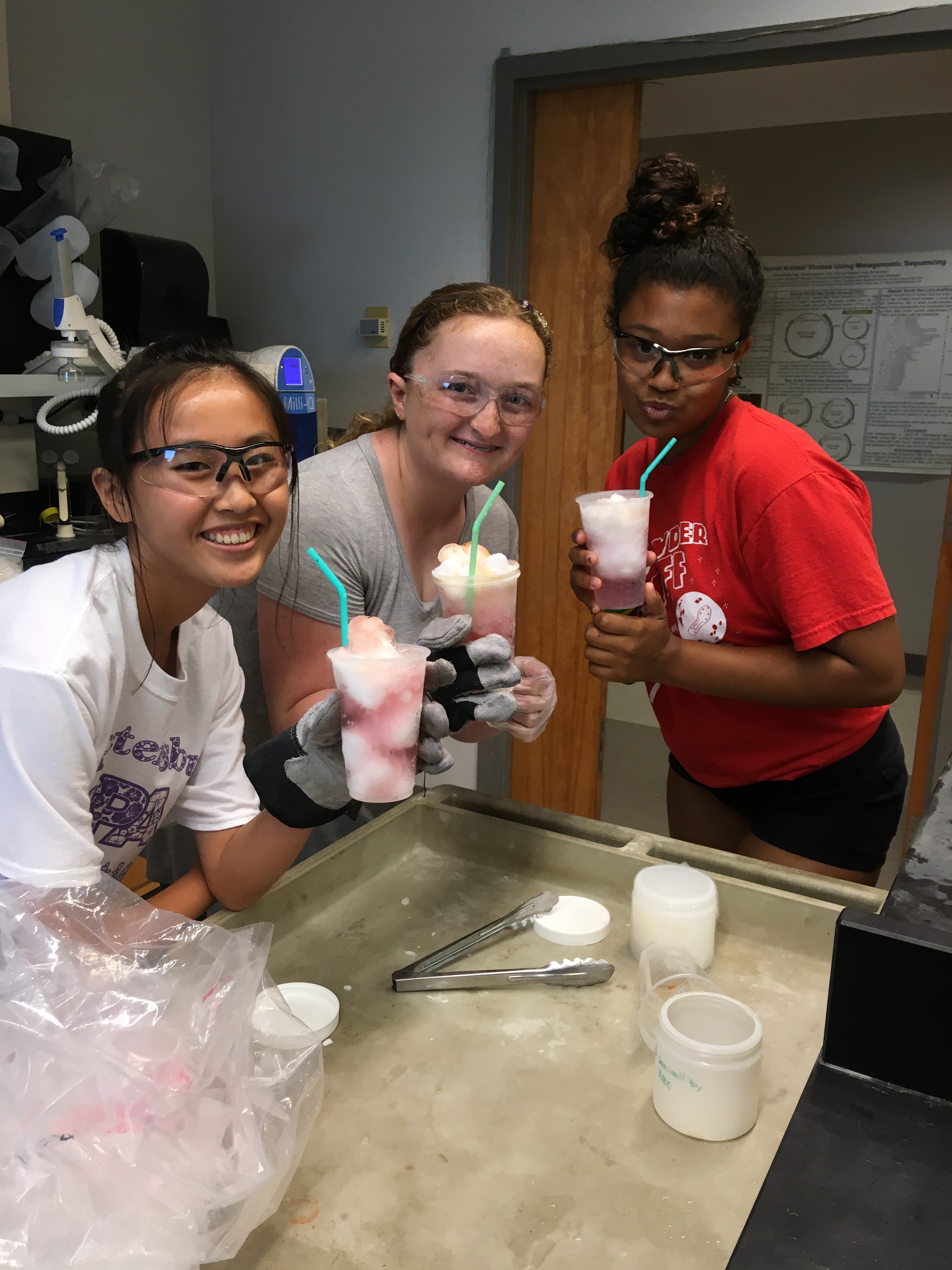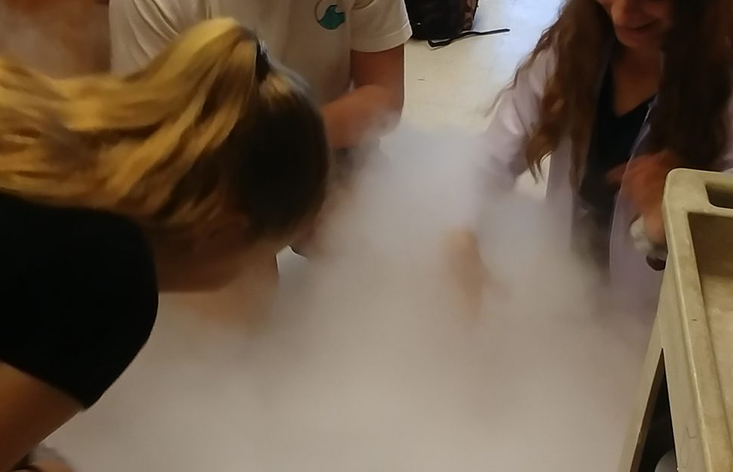This post was contributed by Adrienne Hollister and Shannon Burns, science mentors and College of Marine Science graduate students, and Kady Palmer, College of Marine Science Summer Intern from Eckerd College .
Lab: Ocean Chemistry
Lab Leaders/Contributors: Adrienne Hollister, Shannon Burns, Kady Palmer
We all know that seawater contains salts – but what else? In the Ocean Chemistry labs, campers explored the invisible processes essential to our oceans.
On day 1 of our labs, campers were introduced to the constituents of seawater: water, chloride, sodium, sulfate, magnesium, calcium, and the vast array of trace elements such as iron. Campers visualized the makeup of seawater with colorful bead kits. After learning about seawater chemical constituents, campers were ready to “size up” our oceans. Through a hallway demonstration of a 12-meter logarithmic scale, campers were introduced to the enormous size range of objects in the ocean, from whales (decameters) to atoms (nanometers).
Back in the lab, campers honed in on the molecular end of the size bar by learning all about the role of iron in the oceans. Did you know that iron limits phytoplankton growth in up to 40% of our surface oceans? Even though this micronutrient is essential to all life, it is present in low concentrations in the water column – hence the prefix “micro-” before “nutrient.” In order to increase iron uptake, some bacteria produce iron-binding molecules known as “siderophores” to capture iron and make it more available for biological uptake.
A siderophore is a type of ligand, a molecule that binds to a metal atom. Campers learned about this by role-playing as Iron Women Superheroes and Siderophore Sidekicks. Using a plinko board to represent a water column, with pipe-cleaners as siderophores and ping pong balls as iron atoms, campers saw how bacteria use these ligands to “catch” iron in seawater.
Finally, campers saw ligands at work in real-life chemical reactions! Campers learned all about redox chemistry with the mnemonic device “LEO the lion says GER” (Lose Electrons Oxidation, Gain Electrons Reduction). We aren’t lion’ to you! In the ocean, iron undergoes redox reactions, which include the formation of iron oxide (rust). In our “Tea Time” experiment, campers saw how the iron in steel wool oxidizes in water to form rust, and how this reaction can be altered by adding tea to the mix. Tea contains ligands known as tannins, which quickly reacted with the iron to produce black iron-tannin compounds instead of rust. Who knew that tea could be so tea-rrific?
To wrap up day 1, campers learned about some of the anthropogenic (human) influences on ocean chemistry in our lab “Oil Spill: A Slippery Situation.” After reading about several historic oil spills, the campers simulated the Gulf of Mexico in a large plastic container. Both lab rotations displayed a creative combination of art and science in crafting boats from aluminum foil and pipe cleaners. Next, the campers used cooking oil and food coloring to create a miniature oil spill using two different mechanisms: a surface spill from a boat, and an oil well blow-out at depth using a funnel and tubing. (Bonus question: Which of these was the Deepwater Horizon?). Finally, campers learned all about skimmers, booms, absorbers, and dispersants using a variety of clean-up materials including soap (dispersant), cardboard, foam, packing peanuts, and even tampons.
On day 2, campers had pHun with pH! Our entire second day was devoted to the amazing ocean carbonate buffer system. To wake up, we started out the day with a short field trip around campus to sample water from three different locations: the seawall near KRC, the small freshwater turtle pond, and Haney Landing. Back in the lab, campers used these samples to learn about several different techniques for measuring ocean pH by using different analytical methods. In the process, campers learned the difference between accuracy and precision and were introduced the seawater buffering system.
Afterwards, campers learned that sometimes you can eat chemistry – especially if it’s in the form of molecular marshmallows! Campers used colored mini marshmallows and toothpicks as molecular models for the ocean carbonate buffer system that controls the pH of seawater.

CO2 injection experiment
Finally, it was time to see chemistry in action using the help of colorful pH indicators. In “Respiration Races,” campers saw first-hand how carbon dioxide (CO2) in respiration (breathing) can change the pH of water. Using cups of seawater and tap water with indicator, the campers raced to see who could change the color the fastest through blowing bubbles with a straw. In less than a minute, campers saw the color of their water change from greenish blue to pinkish red as the CO2 from their own breath made it more acidic. Combustion is another way that CO2 can be added to seawater. For the next experiment, campers watched as floating candles changed the color of indicator in water as they burned up. The camper’s favorite way to add CO2 to seawater, however, was using dry ice (a.k.a. frozen CO2). Adding just a small piece of dry ice rapidly changed the color of seawater from basic-blue to acid-red (and produced a spooky fog-machine in the process!) To conclude the lab, campers saw the real-life consequences of ocean acidification by testing solutions at different pHs on seashells. Shells, which are made calcium carbonate, quickly dissolve when exposed to acid. In the end, campers learned that ocean pH is not only fun to test in the lab, but also vitally important to the health of our planet!
